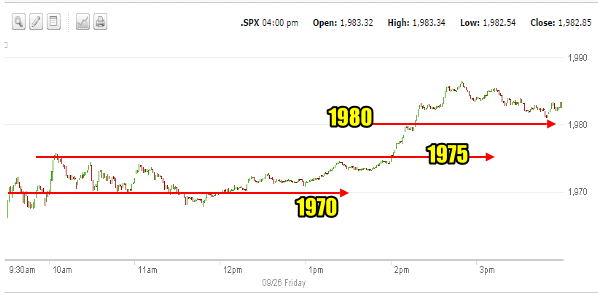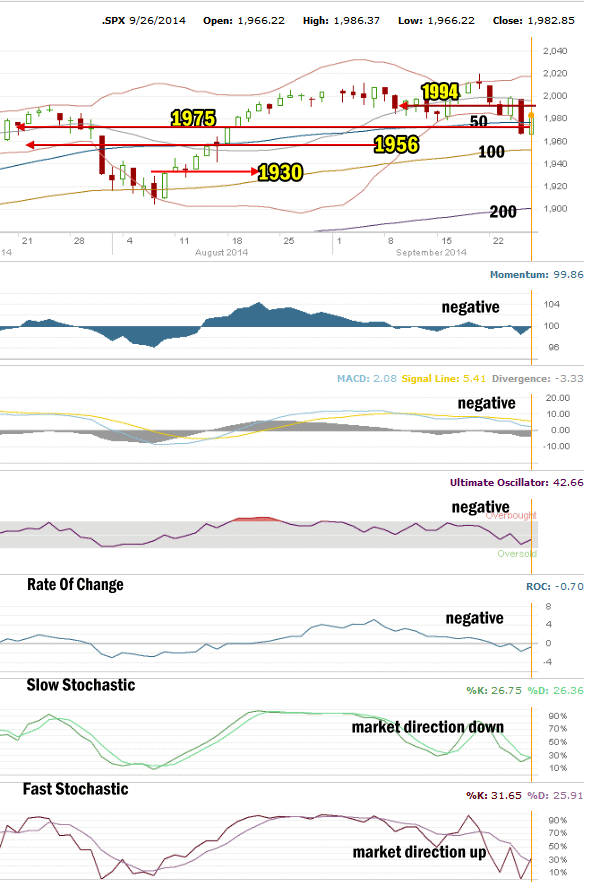The outlook for Friday was for a possible rebound rally, but my opinion was that it will fail and the market will pullback. On Friday though, the rally was very strong and pushed the SPX to close above 1980. Analysts though were not convinced and many felt that the rally not only lacked conviction but is setting the market up to fall back this week. Let’s look first at Friday’s intraday action.
SPX Market Direction Intraday Sept 26 2014
The one minute chart below shows how in the morning investors remained cautious and while they did not sell further, they did little buying. The SPX traded as high as 1975 in the early morning but then fell back to just below 1970 before the noon hour. Many investors seemed convinced over the noon-hour that the selling on Thursday has been overdone and by 1:00 PM the market was back rising. Shortly after 2:00 PM the market regained 1975 and then quickly pushed to 1980 and then 1986 before falling back to close above 1980 at 1982.85 for a gain of 0.86%. The market was once more trading within the 1975 to 1980 valuations.

SPX Sept 26 2014 intraday
Advance Declines For Sept 26 2014
Despite the strong rally, volume dropped by 400 million shares to 2.9 billion. 76% of volume though was up. Still though the number of new lows was 141 while the number of new highs was poor at 16.
The advance decline ratio is telling investors that we need more confirmation that the market direction will start turning out a lot more new highs once again and until that happens, the outlook remains negative for stocks.
Market Direction Closings For Sept 26 2014
The S&P closed at 1982.85 up 16.86. The Dow closed at 17,113.15 up 167.35. The NASDAQ closed at 4,512.19 up 45.45.
Market Direction Technical Indicators At The Close of Sept 26 2014
Let’s review the market direction technical indicators at the close of Sept 26 2014 on the S&P 500 and view the market direction outlook for Sept 29 2014.

Market Direction Technical Analysis for Sep 26 2014
Stock Chart Comments: The rise of the SPX today retook the important 1975 level but volume was poor. The market though managed to recover back above the important 50 day simple moving average (SMA).
1994 Support: The 1994 level has been retested numerous times over the past two and a half weeks and after having been broken through last week, it is now resistance.
1990 Level: This is light support which broke easily on Thursday..
1975, 1956 Support: Both are light support. 1975 is the more significant valuation at this point and was recovered again today..The rebound rally attempt I was expecting happened on Friday and 1975 was retaken.
1930 Support: Light support is found at 1930.
Strong Support Levels are at 1870 and 1840 (no longer shown). At present I am not expecting any break of either of these levels but the Bollinger Bands Squeeze that is developing could be strong enough to break through the 1870 level as the week unfolds. The strength of the decline today makes it quite possible the 1870 level will be reached which would mark a further 5% correction from today’s close.
The other two support levels not shown in the chart above are 1775 and 1750. I have explained that these two are critical support for the present bull market. While 1775 is important, it is 1750 that is now the bottom line.
A break of 1750 would mark a severe correction of more than 13% from the most recent high. This would be the biggest correction since April 2012. A pull-back of that size would definitely stun investors at this point and it is not something I am anticipating as there are no signs of any impending correction of that magnitude.
Momentum: For Momentum I am using the 10 period. Momentum has been the best indicator, replacing MACD as the most accurate indicator. Momentum remained negative on Friday.
MACD Histogram: For MACD Histogram, I am using the Fast Points set at 13, Slow Points at 26 and Smoothing at 9. MACD (Moving Averages Convergence / Divergence) issued a confirmed sell signal on Sept 10. MACD also continued to stay negative on Friday.
Ultimate Oscillator: The Ultimate Oscillator settings are: Period 1 is 5, Period 2 is 10, Period 3 is 15, Factor 1 is 4, Factor 2 is 2 and Factor 3 is 1. These are not the default settings but are the settings I use with the S&P 500 chart set for 1 to 3 months. The Ultimate Oscillator was negative on Friday.
Rate of Change: Rate Of Change is set for a 21 period. The rate of change was negative on Friday.
Slow Stochastic: For the Slow Stochastic I use the K period of 14 and D period of 3. As the Slow Stochastic tries to predict the market direction further out than just one day. The Slow Stochastic is signaling down for the start of the week.
Fast Stochastic: For the Fast Stochastic I use the K period of 20 and D period of 5. These are not default settings but settings I set for the 1 to 3 month S&P 500 chart when it is set for daily. The Fast Stochastic is still signaling up for Monday.
Market Direction Outlook And Strategy for Sept 29 2014
The rally back on Friday took out my positions in the market direction portfolio but as I explained in the investing strategy notes, I bought additional positions on the strong afternoon push higher in the Market Direction.
While Friday was certainly exciting and we could have more movement higher on Monday, the outlook is still lower for stocks. For Monday then I am expecting investors to push stocks up at the start of the day but then move lower. Technically last week did a lot of damage and the market direction up will need more time to repair that damage before moving higher. That means pulling back to support and then building support for another run at the all-time high.
Stay FullyInformed With Email Updates
Market Direction Internal Links
Profiting From Understanding Market Direction (Articles Index)
Understanding Short-Term Signals
Market Direction Portfolio Trades (Members)
Market Direction External Links
IWM ETF Russell 2000 Fund Info
Market Direction SPY ETF 500 Fund Info
